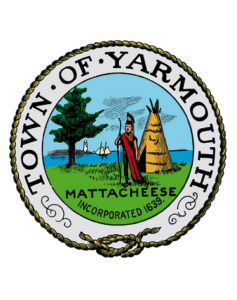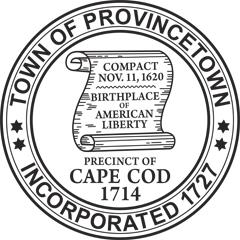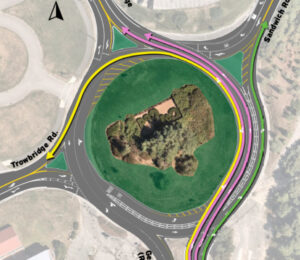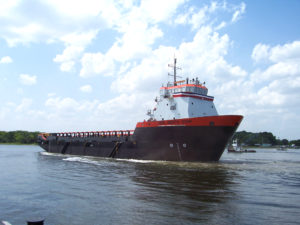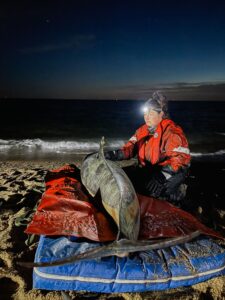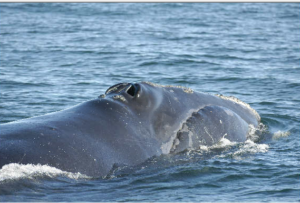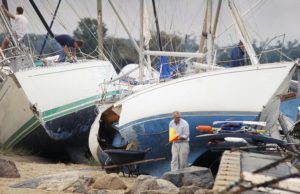
Boat owners gather their belongings, Aug. 20, 1991 in Dartmouth, Mass., after Hurricane Bob swept through southern Massachusetts. The area was closed to the public allowing boat owners to locate and salvage damaged property. (AP Photo/Susan Walsh)
On August 16th 1991 a storm began to develop from an area of low pressure near the Bahamas. As time passed, the storm steadily intensified and began moving toward the northeast, picking up speed and power over the next 48 hours and developing an increasingly defined eye.
Over the next few days Hurricane Bob would wreak havoc on areas of the U.S. eastern seaboard, causing more than 1.4 billion dollars in total damage and destruction. The storm was blamed for causing 17 deaths.
The storm picked up power and became a major hurricane as it made brief landfall on the Outer Banks of North Carolina and slowed as it struck twice more in Rhode Island. When it arrived on Cape Cod, Hurricane Bob was at “Category 2” strength. According to the National Oceanic and Atmospheric Administration, that means sustained winds between 96 and 100 miles per hour, and classification as a storm in which “Extremely dangerous winds will cause extensive damage.”
It was the earliest hurricane to ever hit New England since scientists started keeping track of that sort of thing, and the first to strike during tourist season in nearly five decades. On the Cape, the South Shore, and the Islands, windows were hastily covered with boards or duct tape, and residents and visitors stocked up on ice, water, gasoline, batteries, flashlights, radios, and other provisions in anticipation of what was to come. By 11 AM, Massachusetts Governor William F. Weld had declared a state of emergency, a decree which would remain in place for three days.
The Hurricane stuck the Cape in the late morning of August 19th 1991 and lingered for much of the day. It didn’t take long for officials to close both the Bourne and Sagamore Bridges, the only routes on and off the Cape. Power was knocked out to the entire region. Cape Cod Hospital was operating on generators used to power emergency lights and life-saving equipment but patients were stuck for hours or days in automated beds frozen in position.
Brewster and North Truro experienced gusts of up to 125 mph, with North Truro enduring sustained winds of 100 mph. Trees and utility poles were extensively damaged, leading to blocked roadways and damaged buildings.
According to meteorological reports from the Commonwealth of Massachusetts, “The storm surge in Buzzards Bay was 10 to 15 feet, ripping boats from their moorings, destroying homes, and eroding large sections of coastline. Onset, Bourne and Wareham saw the worst surge, 12 to 15 feet. Mattapoisett was also hit hard, with 29 of 37 homes destroyed on Cove Street and 32 of 35 homes destroyed on Angelica Point. Southern-facing shorelines experienced significant erosion, with some spots along Martha’s Vineyard and Nantucket losing up to 50 feet of shoreline.”
In Mashpee, a 40-foot-wide channel cut through Popponesset Spit; and flooding and wind battered docks and boats. In Bourne, the Tobey Island Bridge was destroyed and Taylors Point flooded. On the Vineyard, Harbormaster Robert E. Gilkes said that the storm sank at least 13 boats, and washed 84 boats ashore. He said one submerged six thousand pound mooring anchor was dragged more than 300 yards by the boat attached to it.
Locals and those visiting the Cape at the height of its tourist season were left to abandon their vehicles on blocked or flooded roads, and many sought accommodation at one of a number of temporary emergency shelters that had been established for the storm. Many of the local shelters were forced to turn people away due to a lack of space, having filled quickly with numerous vacationers fleeing boat yards and yacht clubs who had intended to spend their Cape Cod vacation on their boats, and learned quickly that that was an impossible option with storm surged seas more than a dozen feet higher than usual.
The day following the storm The Washington Post reported that seas were so strong that pleasure crafts and fishing vessels were tossed about like toys, “In Edgartown on the eastern Vineyard, a large boat came to rest in the Harborside Inn’s swimming pool. By 5 p.m., seas had ebbed, and people were out in rowboats in one intersection of Vineyard Haven.”
When it was all over, people left their homes, or hotels, or shelters to find a Cape Cod that was hard to recognize. Hundreds of downed trees and utility poles, power lines left lying wherever they happened to land, broken windows, portions of roofs missing, chunks of roadway gone, feet of sand and cliff eroded from beaches, and what was left of those beaches was now littered with boats of varying sizes, in various states of disrepair.
Vacationers wishing to let family members know that they had made it through the wrath of Bob were largely out of luck because telephone service was unreliable at best.
The day after the storm cleared, Edgartown restaurateur Alan Counsell told reporters that “he was too busy serving cold sandwiches today to worry about seaweed adorning his second-floor lanterns.”
Bickering began almost immediately over the clean-up. If a tree, which had been growing in your yard has now landed completely within my yard, who is responsible for cutting it up and carting it away? If a hunk of my roof has flown into your living room, who covers the repairs? Who is at fault when high winds drive one boat into another, and in the foggy aftermath how do you tell who hit who?
When all was said and done Governor Weld estimated damage in the commonwealth at $1 billion, roughly $800 million of that on the Cape and Islands. That figure, in 1991 dollars, though high, fails to consider the effect that the hurricane had on the last few precious weeks of a multi-million dollar tourist season for a community that depends on that revenue.
Few people sought to spend their waning weeks of summer in a storm pummeled resort community, and even if they had, most of those resorts were too damaged to welcome people. Farmers, who were even more prevalent on Cape back in the early ’90, suffered perhaps most of all with entire crops destroyed by the heavy winds and devastating salt spray.
It would be days, in some cases more than a week, before the power was restored, before the trees were cleared, before the boats could be hauled out of swimming pools and off beaches, longer still before windows could be replaced and the roofs repaired. A prison inmate, who was part of a work program to clean-up, fell off a town truck and hit his head along MacArthur Boulevard and was killed.
The Federal Emergency Management agency chipped in to help out, but relief was slow and focused on public properties, leaving homeowners to comb through insurance documents and wait for relief.
Since that day more than two decades ago, the Cape and Islands have had to grapple with a number of summer and off-season storms, but none have ever come close to the damage wreaked in August of 1991.
According to the National Oceanic and Atmospheric Administration, whenever a hurricane has had a major impact, any country affected by the storm can request that the name of the hurricane be “retired” by agreement of the World Meteorological Organization. Since the 1950’s, 73 names have been retired. For that reason New Englanders, and those the world over may rest assured that there will never be another Hurricane Bob.
By CapeCod.com Staff






